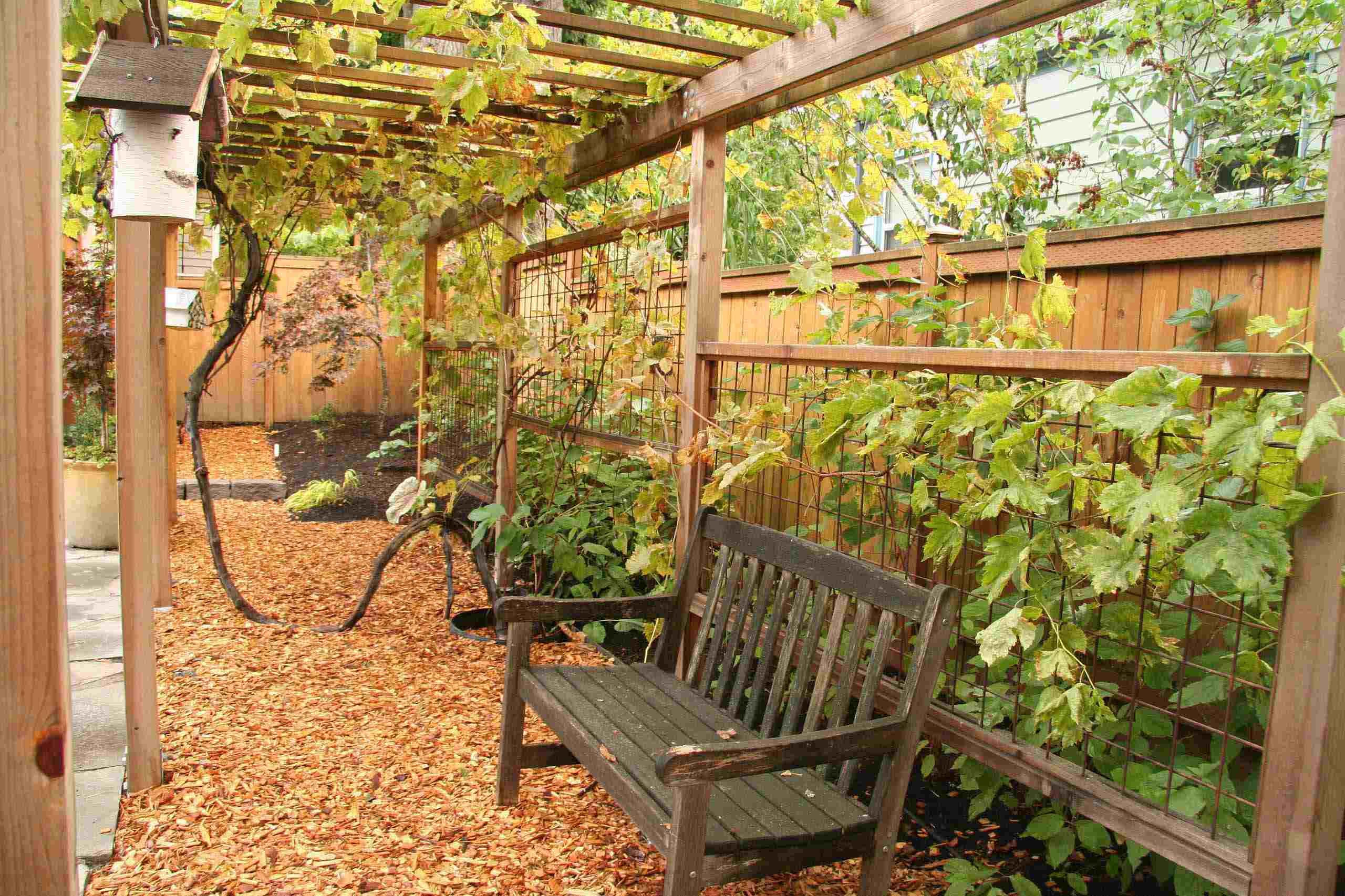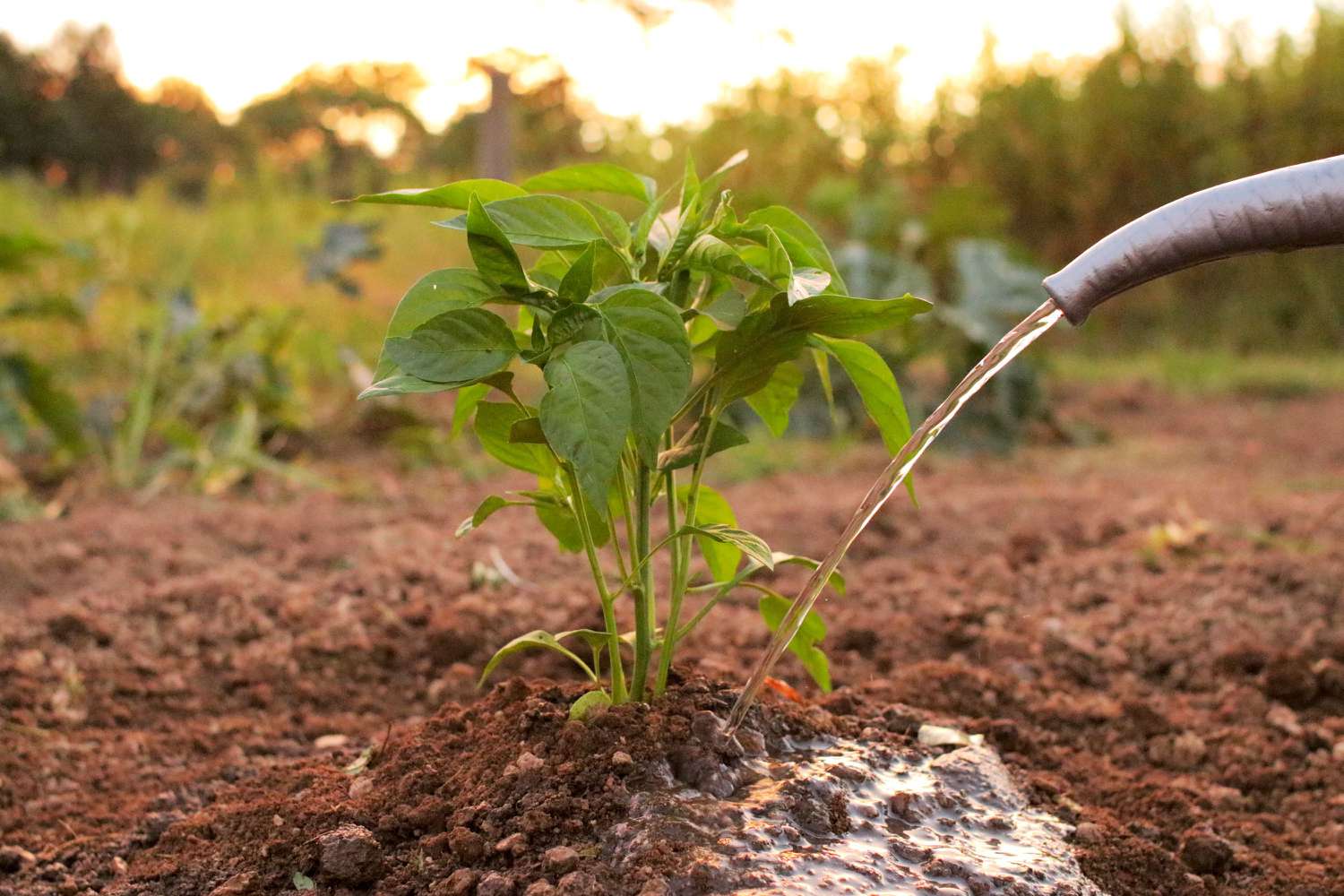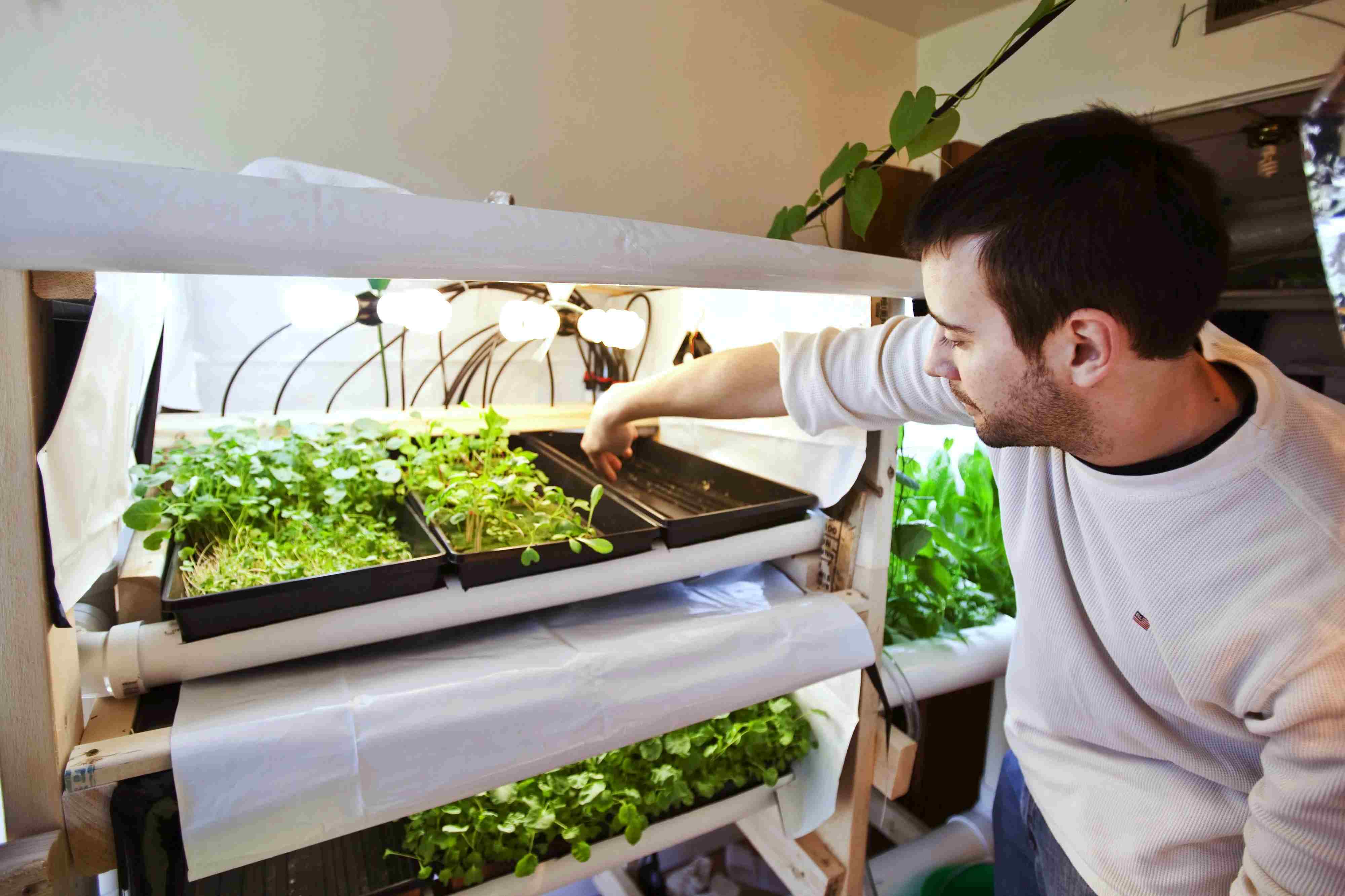Home>Types of Gardening>Edible Gardening>How To Grow Grapes In Backyard


Edible Gardening
How To Grow Grapes In Backyard
Modified: January 22, 2024
Learn how to grow grapes in your backyard with our expert tips and techniques. Discover the joys of edible gardening and enjoy homegrown grapes all year round!
(Many of the links in this article redirect to a specific reviewed product. Your purchase of these products through affiliate links helps to generate commission for Chicagolandgardening.com, at no extra cost. Learn more)
Table of Contents
- Introduction
- Choosing the Right Grape Varieties
- Selecting the Ideal Location
- Preparing the Soil
- Planting the Grapevines
- Providing Adequate Support
- Pruning and Training the Grapevines
- Maintaining Proper Watering
- Fertilizing the Grapevines
- Controlling Pests and Diseases
- Harvesting and Enjoying the Grapes
- Conclusion
Introduction
Welcome to the wonderful world of edible gardening! What better way to enhance your backyard than by growing your own grapes? Imagine plucking ripe, succulent grapes straight from the vine and savoring their sweet juiciness. Whether you’re a seasoned gardener or just starting out, growing grapes in your backyard can be a rewarding and enjoyable experience.
Grapes are not only delicious, but they also offer numerous health benefits. Packed with vitamins, minerals, and antioxidants, grapes are known for their positive effects on heart health, digestion, and immune function. Plus, they make for a delightful addition to salads, desserts, and even wine!
Before you dive into the world of grape growing, it’s essential to equip yourself with knowledge about the right grape varieties, ideal growing conditions, and proper care techniques. By understanding the fundamentals, you’ll be on your way to creating a thriving grapevine that will bear fruit for years to come.
In this article, we will guide you through the ins and outs of growing grapes in your backyard. From selecting the right grape varieties to maintaining proper care throughout the growing season, we’ve got you covered. So, roll up your sleeves and let’s get started on this exciting edible gardening journey!
Choosing the Right Grape Varieties
When it comes to choosing the right grape varieties for your backyard, it’s essential to consider factors such as climate, soil conditions, and your personal preferences. Different grape varieties thrive in different regions, so selecting varieties that are suitable for your specific location is crucial.
Firstly, determine whether you are looking to grow grapes for fresh consumption, making wine, or both. This will help narrow down your choices as certain grape varieties are better suited for specific purposes. For fresh consumption, popular table grape varieties include Thompson Seedless, Flame Seedless, and Ruby Seedless, known for their sweet and juicy flavor. If you’re planning to make wine, varieties like Cabernet Sauvignon, Chardonnay, and Merlot are popular options.
Next, consider the climate of your region. Grapes require a certain number of growing degree days, which is the cumulative measure of warmth during the growing season. Check with your local extension service or a reputable nursery to determine which grape varieties are best suited for your specific climate.
Soil conditions also play a significant role in grape production. Grapes prefer well-drained soil with a pH level between 6 and 7. Conduct a soil test to determine the pH level and nutrient content of your soil. Different grape varieties have different soil preferences, so choose varieties that are compatible with the soil conditions in your backyard.
Lastly, consider your personal preferences in terms of flavor, color, and appearance. Some grape varieties are known for their distinct flavors, such as Muscat for its floral and aromatic notes. Others may have unique colors, like the deep purple of Concord grapes. Consider what appeals to you and aligns with your taste preferences to ensure a truly enjoyable experience.
By choosing the right grape varieties for your backyard, you set the foundation for a successful and fruitful harvest. Take your time to research and select the varieties that best suit your location and preferences, and you’ll be on your way to growing grapes that will exceed your expectations.
Selecting the Ideal Location
When it comes to growing grapes, selecting the ideal location can greatly impact the success and health of your grapevines. Grapes thrive in areas with abundant sunlight, good air circulation, and well-drained soil. Here are some factors to consider when choosing the perfect spot for your grapevines.
Sunlight is crucial for the growth and development of grapes. Look for a location in your backyard that receives at least 6 to 8 hours of direct sunlight daily. Grapes need ample sunlight to ripen properly and develop their sweet flavors. Avoid areas that are shaded by buildings, trees, or other structures that may obstruct sunlight.
Adequate air circulation is essential to prevent fungal diseases and promote healthy growth. Choose a spot that benefits from natural air movement, as stagnant air can create a favorable environment for diseases to thrive. Avoid planting grapevines in low-lying areas where cold air can settle, as this can increase the risk of frost damage.
Next, consider the soil conditions in the selected location. Grapes prefer well-drained soil that is moderately fertile. Avoid areas with heavy clay soil that retains water, as it can lead to root rot and other issues. If your soil is heavy clay, consider amending it with organic matter or creating raised beds to improve drainage.
It’s also important to consider the proximity to other plants and structures. Avoid planting grapevines too close to trees or large shrubs, as they can compete for nutrients and water. Additionally, make sure there is enough space for the grapevines to grow and spread their vines. Adequate spacing allows for better air circulation and easier management.
Lastly, consider accessibility and convenience. Select a location that is easily accessible for maintenance tasks such as pruning, training, and harvesting. Having a nearby water source for irrigation is also beneficial, as grapes require regular watering, especially during hot and dry periods.
By carefully selecting the ideal location for your grapevines, you provide them with the optimal conditions for growth and productivity. A sunny and well-ventilated spot with well-drained soil sets the stage for sturdy vines and high-quality grapes. Take the time to assess your backyard and choose a location that meets these requirements, and you’ll be well on your way to a successful grape-growing endeavor.
Preparing the Soil
Before planting your grapevines, it’s important to prepare the soil to provide a healthy and nutrient-rich environment for their roots to thrive. Proper soil preparation will not only promote optimal growth but also improve disease resistance and overall grape production. Here are some steps to follow when preparing the soil for your grapevines.
Start by clearing the area of any weeds, grass, or other vegetation that may compete with the grapevines for nutrients and water. Remove any rocks, debris, or large clumps of soil that may hinder root development. This helps create a clean and favorable space for the grapevines to establish themselves.
Once the area is clear, consider conducting a soil test to determine its pH level and nutrient content. Grapes prefer slightly acidic to neutral soil with a pH range of 6.0 to 7.0. If the pH is too low, meaning the soil is highly acidic, you may need to add agricultural lime to adjust and bring it closer to the desired range.
Next, incorporate organic matter into the soil to improve its fertility and structure. This can be done by adding compost, well-rotted manure, or other organic materials. Organic matter helps enhance soil drainage, water-holding capacity, and nutrient availability. Work the organic matter into the top 12 to 18 inches of soil to ensure it is evenly distributed.
After incorporating organic matter, consider adding additional nutrients to the soil based on the results of the soil test. This can be done by using organic fertilizers or granular fertilizers specifically formulated for grapes. Follow the recommended application rates and mix the fertilizer into the top layer of soil to ensure it is evenly distributed and readily available for the grapevines.
Once the soil is enriched with organic matter and nutrients, it’s time to prepare the planting holes for the grapevines. Dig holes that are wide enough to accommodate the roots of the grapevines and deep enough so that the bud union, which is the swollen region where the scion is attached to the rootstock, is just above the soil line.
Finally, give the soil a gentle rake to create a smooth and even surface. This will provide a stable planting environment for the grapevines and facilitate water penetration. Avoid compacting the soil excessively, as it can hinder root growth and drainage.
By properly preparing the soil, you create a foundation for healthy root development and successful grapevine growth. Incorporating organic matter, balancing the pH, and providing essential nutrients will set the stage for thriving grapevines that yield high-quality fruit. Take the time to prepare the soil before planting, and you’ll be rewarded with bountiful grape harvests for years to come.
Planting the Grapevines
Once you have selected the right grape varieties and prepared the soil, it’s time to plant your grapevines. Proper planting techniques are crucial for the establishment and long-term success of your grapevines. Follow these steps to ensure a successful planting process.
First, dig a hole that is wide and deep enough to accommodate the root system of the grapevine. The hole should be slightly larger than the roots to allow for proper root expansion. Gently loosen the roots and place the grapevine in the hole, making sure the bud union is just above the soil line.
Next, backfill the hole with soil, ensuring that it is evenly distributed and there are no air pockets around the roots. Tamp down the soil gently to provide stability to the grapevine. Avoid compacting the soil excessively as it can limit root growth and water drainage.
After planting, create a small mound of soil around the base of the grapevine. This helps direct water towards the roots and encourages proper establishment. Water the newly planted grapevine thoroughly, allowing the water to penetrate the soil and reach the roots.
Provide some form of support for the grapevine to grow on. This can be a trellis, arbor, or fence. Make sure the support structure is strong and securely anchored in the ground. As the grapevine grows, gently train the main stems or canes along the support system to guide their growth trajectory.
Apply a layer of mulch around the base of the grapevine to conserve moisture, suppress weed growth, and regulate soil temperature. Use organic mulch, such as wood chips or straw, and spread it in a layer about 2-3 inches thick. Avoid piling the mulch directly against the stem of the grapevine to prevent rot.
Regularly monitor the moisture level of the soil and water as needed. Grapes require regular watering, especially during dry periods. Water deeply to encourage deep root growth and reduce the frequency of watering.
Lastly, protect the newly planted grapevines from extreme weather conditions, such as strong winds and frost. Consider using windbreaks or providing temporary coverings during severe weather events. This will help prevent damage to the young grapevines and ensure their successful establishment.
By following these planting guidelines, you provide your grapevines with the best chance for success. Proper planting techniques promote healthy root development and establishment, setting the stage for vigorous growth and abundant grape production in the seasons to come.
Providing Adequate Support
As grapevines grow, they require proper support to ensure their vines can spread, bear the weight of the grape clusters, and receive adequate sunlight and airflow. Providing the right support system is essential for the health and productivity of your grapevines. Here are some key considerations when it comes to supporting your grapevines.
One of the most common and effective support systems for grapevines is the trellis. A trellis consists of sturdy posts set in the ground, with horizontal wires or strings running between them. The number of wires or strings will depend on the grape variety and training system you choose.
When setting up the trellis, ensure that the posts are securely anchored in the ground to withstand the weight of the growing vines and grape clusters. The wires or strings should be taut but flexible enough to allow for vine growth and tension adjustments as needed.
Training the grapevines along the trellis is key to optimizing their growth and productivity. There are several training systems to choose from, including the vertical shoot positioning (VSP), high cordon, and Geneva double curtain systems. Each system has its own advantages, so choose one that suits your space, grape variety, and personal preference.
When training the vines, gently tie them to the wires or strings using plant ties or soft twine. Ensure that the ties are secure but not too tight to prevent restricting growth or damaging the vine. Regularly check the ties and adjust them as the vines grow to prevent girdling.
In addition to the trellis, consider providing additional support for heavy grape clusters. This can be done using netting, mesh bags, or even individual supports. These supports help prevent the weight of the grapes from pulling down the vines or causing them to break. Be mindful of the weight and size of the grape clusters and adjust the supports accordingly.
Regularly inspect the trellis and support system for any signs of damage or wear. Repair or replace any broken posts, wires, or ties to maintain the structural integrity and functionality of the support system. A well-maintained trellis ensures proper vine growth, adequate sun exposure, and improved airflow, reducing the risk of diseases and increasing grape quality.
Lastly, prune the grapevines according to your chosen training system. Pruning helps maintain proper vine structure, promotes fruiting, and prevents overcrowding. Remove any dead, damaged, or diseased wood, and prune back excessive growth to maintain manageable vine size and ensure optimal productivity.
By providing adequate support for your grapevines, you create a sturdy and organized structure for them to grow and thrive. A well-designed trellis and training system allow for proper vine development, improved sun exposure, and ease of maintenance. Take the time to set up a reliable support system and carry out regular maintenance to support the health and productivity of your grapevines.
Pruning and Training the Grapevines
Proper pruning and training techniques are essential for maintaining the health, structure, and productivity of grapevines. Pruning helps remove excessive growth, improve airflow and sun exposure, and promote the development of healthy fruiting wood. Training, on the other hand, directs the growth of the grapevines along a specific structure or trellis. Let’s delve into the key aspects of pruning and training grapevines.
The timing of pruning is crucial to ensure the success of your grapevines. It is typically done during the dormant season, which is late winter to early spring before new growth begins. Pruning during this time allows you to easily identify and remove any dead, damaged, or diseased wood.
Start by removing any extra canes or shoots that may have developed during the growing season. Select the strongest and most vigorous canes for training and remove the others. The number of canes to retain will depend on the training system you are using, as different systems have specific requirements.
When pruning, make clean cuts using sharp pruning shears. Cut just above a bud to encourage new growth. Orient the cut at a slight angle to allow rainwater to run off and prevent water pooling, which can lead to disease or rot.
During the first few years of a grapevine’s life, training is crucial to establish the desired structure. There are various training systems to choose from, such as the high cordon, bilateral cordon, or the fan system. These systems help guide the growth of the grapevines along the support structure and optimize sun exposure.
When training the grapevines, gently tie the canes to the support wires or trellis using plant ties or soft twine. Spread out the canes to ensure proper airflow and sun exposure. As the vine grows, periodically adjust the ties to accommodate new growth and prevent girdling.
Keep in mind that not all grape varieties require the same pruning and training methods. Some varieties are more vigorous and may benefit from different pruning techniques. It’s important to research and understand the specific needs and growth habits of the grape variety you are cultivating.
Regularly monitor the growth of the grapevines and perform maintenance pruning as needed throughout the growing season. Remove any suckers or unwanted growth that may emerge from the base of the plant. This helps maintain the overall health and vitality of the grapevine.
Proper pruning and training practices promote a well-structured and balanced grapevine, leading to improved fruit production and quality. Regular maintenance and monitoring ensure that the grapevines remain healthy and productive as they continue to grow and mature.
Maintaining Proper Watering
Adequate and consistent watering is crucial for the health and productivity of grapevines. Proper watering ensures that the vines receive the necessary moisture for growth, development, and fruit production. Here are some key factors to consider when it comes to maintaining proper watering for your grapevines.
Understanding the water requirements of grapevines is essential to prevent both under- and over-watering. During the early stages of growth, grapevines require regular watering to encourage root establishment. As the vines mature, they become more drought-tolerant but still require consistent moisture, particularly during hot and dry periods.
The frequency and amount of water needed will depend on various factors such as climate, soil type, and stage of growth. In general, grapevines benefit from deep but infrequent watering. This encourages the roots to grow deeper into the soil, promoting a healthier and more robust root system.
One effective method of watering grapevines is through drip irrigation. Drip irrigation delivers water directly to the root zone, reducing water wastage and minimizing the risk of foliar diseases. This method helps ensure that the water reaches the roots where it is needed most efficiently.
Monitor the moisture content of the soil regularly to determine when to water. Use a probe, such as a finger or a moisture meter, to check the soil moisture levels around the root zone. Water the grapevines when the soil feels dry to the touch, but avoid letting it become bone dry.
Avoid over-watering, as excessive moisture can lead to root rot and other problems. Watering too frequently or providing too much water can suffocate the roots and hinder their ability to absorb oxygen. This can result in weakened vine growth and increased susceptibility to diseases.
Mulching is beneficial for maintaining soil moisture and reducing water evaporation. Apply a layer of organic mulch, such as wood chips or straw, around the base of the grapevines. This helps regulate soil temperature, suppress weed growth, and conserve moisture.
Consider the specific needs of your grapevine variety when determining watering requirements. Some grape varieties may have different water requirements based on their growth habits and the characteristics of their fruit. Research and consult local experts or nurseries to gain a better understanding of your specific grape variety’s water needs.
Finally, adjust watering practices based on weather conditions. In periods of heavy rainfall, reduce or suspend irrigation to prevent over-saturation and waterlogging. Conversely, during prolonged dry spells or heatwaves, increase watering to prevent dehydration and stress on the grapevines.
By maintaining proper watering practices, you provide the grapevines with the necessary moisture for healthy growth and fruit development. Consistent watering, along with adequate soil moisture monitoring and adjustments, ensures that your grapevines receive the hydration they need to thrive and produce high-quality grapes.
Fertilizing the Grapevines
Fertilizing grapevines is crucial for providing the necessary nutrients for optimal growth, fruit production, and overall plant health. Proper fertilization practices help ensure that grapevines have access to essential elements, resulting in vigorous vines and high-quality grapes. Here are some important considerations when it comes to fertilizing grapevines.
Before applying any fertilizer, it’s important to conduct a soil test to determine its nutrient composition and pH level. This information will guide you in selecting the appropriate fertilizers and making any necessary soil amendments. Soil tests can be done through a local extension service or a reputable soil testing laboratory.
One of the primary nutrients that grapevines require is nitrogen (N). Nitrogen is essential for promoting vigorous vegetative growth. However, excessive nitrogen can result in excessive foliage growth at the expense of fruit production. It is important to balance the application of nitrogen to meet the specific needs of grapevines.
Phosphorus (P) is another important nutrient for grapevines, as it aids in root development and fruit production. Incorporate phosphorus-rich fertilizers during the initial planting stages to support healthy root establishment. Subsequent applications should be based on the results of soil testing to maintain adequate levels.
Potassium (K) is vital for overall plant health and disease resistance. It aids in fruit development, improves water regulation, and boosts tolerance to stress. Potassium deficiencies can result in reduced fruit quality and increased susceptibility to diseases. Regularly monitor potassium levels and apply appropriate fertilizer if necessary.
In addition to the primary nutrients, grapevines also benefit from secondary and micronutrients. These include calcium, magnesium, iron, zinc, and others. These nutrients are often present in sufficient quantities in the soil but may need supplementation in certain cases. Soil tests will provide insight into any deficiencies that need to be addressed.
The timing and frequency of fertilizer applications depend on various factors, including the age of the grapevines and the soil conditions. In general, it is best to apply fertilizers in early spring before the growing season begins. This helps provide a nutrient boost to support healthy growth. Follow up with additional applications as needed throughout the growing season based on soil test recommendations.
It is important to follow the recommended rates and application methods provided on the fertilizer packaging. Avoid over-application of fertilizers, as this can lead to nutrient imbalances and environmental pollution. Always water the grapevines after applying fertilizers to help facilitate nutrient uptake by the roots.
Organic fertilizers, such as compost, well-rotted manure, and composted mulch, can also be used to enrich the soil and provide a slow release of nutrients. These organic amendments not only provide essential nutrients but also improve soil structure and promote beneficial microbial activity.
Regular monitoring of the grapevines’ growth and appearance is essential to assess their nutrient needs. Pay attention to signs of nutrient deficiencies, such as yellowing leaves, stunted growth, or poor fruit development. Promptly address any nutrient imbalances through appropriate fertilization.
By following proper fertilization practices, you provide grapevines with the essential nutrients they need for vigorous growth, optimal fruit production, and overall plant health. Regular soil testing, balanced nutrient applications, and monitoring the vines’ response will help ensure that your grapevines thrive and produce high-quality grapes.
Controlling Pests and Diseases
Just like any other plants, grapevines are susceptible to various pests and diseases that can damage or even destroy the crops. Effectively controlling pests and diseases is essential for maintaining the health and productivity of your grapevines. Here are some important strategies to consider when it comes to pest and disease management.
Regular monitoring of your grapevines is the first step in identifying and preventing pest and disease problems. Keep a close eye on the leaves, stems, and the overall health of the vines. Look out for signs of damage, such as chewing marks, discoloration, wilting, or unusual growth patterns. Early detection is key to implementing effective control measures.
Implement cultural practices that discourage pests and diseases. This includes proper sanitation, such as removing fallen leaves and debris, which can harbor pests and pathogens. Prune grapevines to improve airflow and reduce moisture on the leaves, as this can minimize the risk of fungal diseases.
Select disease-resistant grape varieties whenever possible. Disease-resistant varieties are less susceptible to common grape diseases and may require less intensive management. Consult with local experts or nurseries to identify disease-resistant varieties that are suitable for your region and growing conditions.
Apply appropriate pesticides only when necessary and in accordance with local regulations. Avoid routine or excessive pesticide use, as this can lead to pesticide resistance and harm beneficial insects. When choosing pesticides, select those that target the specific pest or disease you are dealing with, and follow the label instructions carefully.
Encourage natural predators and beneficial insects in your vineyard by providing habitat and food sources. Beneficial insects, such as ladybugs and lacewings, help control common grape pests, including aphids and mites. Avoid using broad-spectrum insecticides that can harm these helpful creatures.
Control weeds around the grapevines, as they can provide a refuge for pests and diseases. Mulch or use cover crops to suppress weed growth and enhance soil moisture retention. It’s important to maintain a weed-free zone around the base of the grapevines to reduce competition and potential pest and disease issues.
Regularly scout the grapevines for common grape pests, such as aphids, grape berry moth, or Japanese beetles. Early detection allows for prompt intervention, reducing the likelihood of a severe infestation. Use appropriate pest control tactics, including manual removal, traps, or targeted sprays, to reduce pest populations.
Maintain proper irrigation practices to avoid creating a conducive environment for diseases. Overly wet conditions can lead to fungal diseases, such as powdery mildew or downy mildew. Use irrigation methods that minimize foliage wetness, such as drip irrigation, and water during the early morning to allow leaves to dry quickly.
Regularly assess the overall health of your grapevines and be prepared to take action if a disease outbreak occurs. Consult with local horticulture or agricultural extension services, as they can provide guidance on specific management strategies or recommend appropriate fungicides or treatments for common grapevine diseases.
By implementing a proactive and integrated approach to pest and disease management, you can mitigate damage and maintain the health and productivity of your grapevines. Regular monitoring, cultural practices, careful pesticide use, and promoting beneficial insects are all key components of effective pest and disease control in the vineyard.
Harvesting and Enjoying the Grapes
After months of tending to your grapevines, the time will finally come to harvest the fruits of your labor. Harvesting grapes at the right time ensures optimal flavor, sweetness, and overall quality. Here are some important guidelines to follow when harvesting and enjoying your homegrown grapes.
Timing is crucial when it comes to grape harvest. Grapes are typically harvested when they have reached their ideal sugar levels and flavor development. This can vary depending on the grape variety and its intended use. For table grapes, harvest when the grapes are fully colored and slightly soft to the touch. For wine grapes, monitor the sugar levels and acidity to determine the optimal time for picking.
Harvesting grapes is a delicate process that requires gentle handling to prevent damage to the grape clusters. Use sharp pruning shears or scissors to cut the grape clusters from the vines, leaving a short stem attached. Avoid pulling or tugging on the clusters, as this can result in bruising or detachment of the berries.
Place the harvested grape clusters in shallow containers or baskets to prevent them from being crushed under their own weight. Use care when transporting harvested grapes to prevent bruising or jostling, which can affect their quality. Avoid overcrowding or piling the clusters too high to ensure proper air circulation and minimize damage.
Once harvested, it’s time to savor the fruits of your labor. Grapes can be enjoyed fresh as a healthy and delicious snack. Wash the grapes gently before eating, and remove any stems or damaged berries. Grapes make a perfect addition to fruit salads, cheese platters, or even as a topping for yogurt or ice cream.
If you’re interested in making your own wine or juice, grapes can be used for that purpose as well. Crush the harvested grapes to extract the juice, and follow a specific recipe or fermentation process to create your homemade wine or juice. This can be a rewarding and enjoyable endeavor for wine enthusiasts.
Proper storage is crucial to extend the shelf life of harvested grapes. Store them in a cool place, such as a refrigerator, to maintain their freshness and flavor. Grapes can keep well for up to a week when stored properly. Avoid washing grapes before storage, as excess moisture can promote spoilage.
Remember to take time to appreciate and celebrate the fruits of your hard work. Share the joy of homegrown grapes with family and friends, and savor the flavors and aromas that your grapevines have produced. Embrace the sense of accomplishment that comes with successfully growing and harvesting your own grapes.
Growing, harvesting, and enjoying your own grapes is a gratifying journey. By following proper harvesting techniques and creatively incorporating grapes into your culinary endeavors, you can fully appreciate the rewards of your edible gardening efforts.
Conclusion
Congratulations on embarking on the journey of growing your own grapes! Edible gardening is a rewarding endeavor, and growing grapes in your backyard can provide you with a bountiful harvest and a sense of accomplishment. By following the guidelines and tips provided in this article, you are well on your way to successfully cultivating healthy and productive grapevines.
From choosing the right grape varieties and selecting the ideal location to preparing the soil, planting the grapevines, providing adequate support, and maintaining proper watering, fertilizing, and pest control, each step plays a crucial role in the overall success of your grape-growing venture.
Remember to be patient and attentive throughout the process. Growing grapes requires time, effort, and consistent care. Take the time to observe and learn from your grapevines, adjusting your practices as needed to ensure their optimal health and productivity.
As your grapevines mature and bear fruit, enjoy the fruits of your labor. Whether you indulge in fresh grapes straight from the vine, create homemade juice or wine, or share your harvest with loved ones, take the opportunity to appreciate the flavors, aromas, and beauty that your grapevines have brought to your backyard and table.
Continue to expand your knowledge and skills in the realm of edible gardening. Experiment with different grape varieties, explore advanced techniques like grafting or vine propagation, and connect with fellow gardeners or local vineyards for additional insights and tips.
Remember, growing grapes is a journey of learning and discovery. Embrace the challenges and triumphs along the way, and enjoy the experience of nurturing a living plant that brings joy and delight to your life.
So, roll up your sleeves, gather your tools, and let the journey of growing grapes in your backyard begin. With dedication, patience, and a little bit of green-thumb magic, you’ll be rewarded with a fruitful grape harvest that will leave you proud and satisfied.










